I want to apply custom ticks to my plot with matplotlib to offset the labels of a 3D bar graph by half the column width, similar to this post. Here is my code:
from matplotlib import pyplot as plt
from numpy import arange, meshgrid, abs, zeros_like
import mpl_toolkits.mplot3d
def barplot3d(x, y, z, centerLabels = True):
x0 = x[:, 0]
y0 = y[0, :]
x = x.flatten()
y = y.flatten()
z = z.flatten()
z0 = zeros_like(z)
fig = plt.figure()
ax = fig.add_subplot(111, projection = "3d")
ax.set_xticks(x0 + 0.5)
ax.set_xticklabels(x0)
ax.set_yticks(y0 + 0.5)
ax.set_yticklabels(y0)
ax.bar3d(x, y, z0, 1, 1, z)
plt.show()
x = arange(-10, 10)
y = arange(10)
mx, my = meshgrid(x, y, indexing = "ij")
z = abs(mx * my - (mx + 2 * my))
barplot3d(mx, my, z)
It works fine. However, this will always plot all ticks, one for each row/column in z which results in crowded x and y axes. See the following image of the plot created usign the above code:
How can I adjust this so that it is as close as possible to the result I would obtain from using the automatically created labels? That is, how can I decide which labels to take and which to discard? Can I still somehow use the automated "system" that decides this while specifying the label positions?
